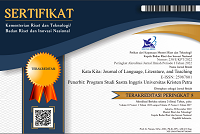SPEECH STYLES USED BY YOUNG FEMALE AND MALE TEACHERS IN TEACHING ENGLISH TO THEIR OLDER STUDENTS
DOI:
https://doi.org/10.9744/katakita.3.2.20-26Keywords:
Keadilan Organisasional, Motivasi Kerja, Kepuasan Kerja KaryawanAbstract
This study discussed about the speech styles used by a young female and a young male teacher in teaching English to their older students, the tendencies of using the features of each speech styles, and the use of opposite gendered speech styles. Through the classroom observation, the findings showed that the young female teacher applied six features of female speech styles and five features of male speech styles while the findings of theyoung male teacher showed that he only applied five features of male speech styles and applied six features of female speech styles.From the findings, it could be concluded that the most dominant speech styles used by the young female teacher is ‘Female Speech Style’ and the most dominant feature is ‘Co-operative’. And, the most dominant speech styles used by the young male teacher is ‘Male Speech Style’ and the most dominant feature is ‘Co-operative’ feature of female speech styleReferences
Baxter, J. (2010). The language of female leadership.London: Palgrave Macmillan.
Hill, E. (2009). Do mothers and fathers differ in their speech styles when speaking to their children? Are there speaker gender effects on parents’ language behaviour?.INNERVATE Leading Undergraduate Work in English Studies, 2(2009-2010), 163-182.
Holmes, J. (2006). Gendered talk at work. Oxford: Blackwell.
Litosseliti, L. (2013). Gender & language theory and practice.New York: Routledge.
Wagner, S. E. (2012). Age grading in sociolinguistics theory. Language and Linguistics Compass,6(6),371-382.
Downloads
Issue
Section
License
Authors who publish with this journal agree to the following terms:- Authors retain copyright and grant the journal right of first publication with the work simultaneously licensed under a Creative Commons Attribution License that allows others to share the work with an acknowledgement of the work's authorship and initial publication in this journal.
- Authors are able to enter into separate, additional contractual arrangements for the non-exclusive distribution of the journal's published version of the work (e.g., post it to an institutional repository or publish it in a book), with an acknowledgement of its initial publication in this journal.
- Authors are permitted and encouraged to post their work online (e.g., in institutional repositories or on their website) prior to and during the submission process, as it can lead to productive exchanges, as well as earlier and greater citation of published work (See The Effect of Open Access).














